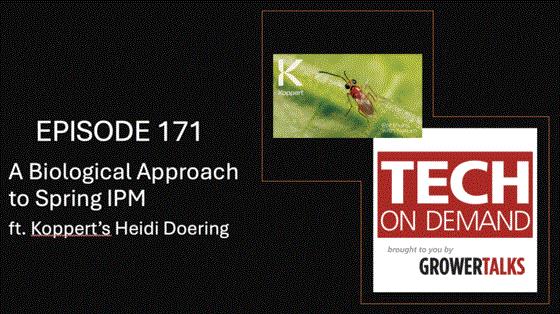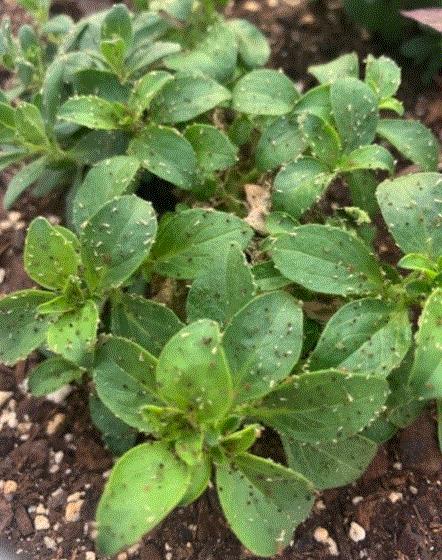NEW PODCAST! Biological IPM for Spring 2025
Tech On Demand podcast episode 171 is all about spring pest control, integrated pest management and implementing biocontrol strategies that work. I’m joined by Heidi Doering, the National Ornamental Team Lead and Technical IPM Consultant for the Midwest Region with Koppert. Heidi has been with Koppert for almost 10 years, and she also has a broad range of horticultural experience, from greenhouse production to product management and sales, which gives her a unique perspective and breadth of knowledge to find unique IPM solutions for growers wherever they’re at on the continuum of chemical, biological and hybrid approaches. She’s also written articles for GrowerTalks and the Koppert Corner section of this newsletter recently.

In THIS EPISODE, we discuss what she’s seeing and hearing as spring production ramps up across North America, her role as a “greenhouse CSI” when walking into a facility and meeting with owners and growers, common spring pests and potential prevention and management strategies, education and planning as they relate to biological IPM, the importance of relationships, and her thoughts on Thrips parvispinus, the pepper thrips hitchhiking their way North on tropical plants. Be sure to listen all the way to the end of this fantastic discussion because it’s packed with tips and tricks.
Be sure to subscribe to the Tech On Demand podcast on your favorite app so you never miss an episode. And if you’re not a regular listener, jump back into the archives and get caught up—there are 172 episodes as of today, with many more in the works.
TECH ON DEMAND ON SPOTIFY
TECH ON DEMAND ON APPLE PODCASTS

Nick’s Tip of the Week: Aphids on Hanging Baskets … Ugh!
Each week, I’ll work with my buddy Nick Flax, a technical services expert at Ball, to share a concern that’s come up during one of his numerous calls with growers across North America. This week, he’s proactively sharing tips for aphid prevention and control, because with this common spring pest it’s not if … it’s when.
PROBLEM: Every year, I get calls about aphids. This time of year, when greenhouse life is crazy, it’s easy to let things slip by, but one thing to keep on your radar in the coming weeks is pest management.
This time of year, I always hear from growers (mainly in the south) dealing with aphid outbreaks, particularly in hanging basket crops. Oftentimes, we transplant plugs and liners into baskets, set them on benches or floors for a little while to root in, hang them up on basket lines … and then forget about them. When HBs are out of your direct line of sight, it’s easy to accidentally skip them during your weekly pest scouting routine.

NICK’S TIP: Forgetting to check your baskets for pests can quickly lead to compromised crop quality and problems raining down on your crops on the benches below. While this week’s tip focuses on aphid pressure in HBs, keep in mind that other pests like thrips, spider mites and broad mites can also get into your basket crops and wreak havoc if they go unchecked. Let’s take a look at some strategies for scouting and controlling aphids in your basket crops.
Scouting. It’s easier to take a glance at your yellow/blue sticky cards when they’re at a normal working level, but these are still great tools to use up high in your baskets. On the bench, common practice is to place one sticky card for every 500 to 1,000 sq. ft. of growing area, but that doesn’t make much sense in a single-file line of HBs.
-
Place about three sticky cards per basket line; one toward each end and another somewhere in the middle. This will give you a good idea of what pest distribution looks like in your HBs.
-
Hang a flag from baskets that you are monitoring. This will make it easier to find the baskets containing your sticky cards, especially when crops develop and start spilling over the sides.
-
Know your “aphid magnet” crops and scout these more rigorously. Aphids seem to love calibrachoa and verbena, so keep an especially close eye on monoculture baskets or combos with either of these components.
Deploying Biologicals. Since applying pesticides to HBs high up on their hangers can be challenging, consider implementing proactive IPM using predators and parasitoids of aphids in your hanging crops. Ask your biosolutions supplier which BCAs they recommend for aphids in your specific situation. Here are a couple that have proven effective.
-
Aphidius ervi is a parasitic wasp that preys upon aphids and is generally more effective at controlling large aphid species, like foxglove and potato aphids.
-
Aphidius colemani is another parasitic wasp that preys upon smaller aphid species, such as green peach and cotton aphids.
These will be most effective when deployed early in the crop cycle before aphids can gain a foothold. As with pretty much all predatory and parasitic biologicals, new batches need to be continually released into your crop to ensure the beneficial insect population is reinvigorated and outnumbers the target pests.
Insecticide Use & Preventative Control. If a tightly managed biocontrol program isn’t enough to keep up with explosions of aphid pressure in your baskets, you may want to consider breaking out the big guns and applying a systemic insecticide that will provide long-term control. This gives you somewhat of an insurance policy against sudden spikes in pest populations … especially if they appear in large numbers unexpectedly from outdoors. Try to exhaust all other IPM measures before resorting to the use of systemic insecticides. However, if you experience significant losses due to aphid and other insect pest damage, treating baskets with a systemic insecticide shortly after transplant can be an effective strategy to keep problem-pest populations from reaching critical mass.
While the use of systemic insecticides is a contentious topic, preventative control of pests using systemics early in the season when plants are vegetative and non-target insects are not present can greatly reduce potential risks. Always follow label regulations when applying insecticides and be sure you understand your customers’ expectations when it comes to use of different IPM products like systemics before treating your crops.

NEW PODCAST #2: An Industry Initiative Roundtable Discussion
Proving I’m not territorial and am happy to turn the golden TOD mic over to others from time to time, Episode 172 of the Tech On Demand podcast, brought to you by GrowerTalks, dropped this week featuring members of the marketing committee of That Flower Feeling joining special guest host Joan Mazat (Business Manager—Cut Flowers at Ball Seed Company) to share why this movement is so important to the cut flower industry (and all of horticulture, actually).
Join this dynamic group for an EQUALLY DYNAMIC DISCUSSION about how and why industry leaders are actively working to motivate more consumers to view fresh flowers as a central part of their everyday routines, thereby raising overall floral integration and consumption. Flowers offer so many benefits—from sell-care to relaxation and reflection, expressions of gratitude and good vibes.

Joan is joined by guests Karen Oie—Director of Sales, Smithers-Oasis North America; Lisa Nason—Director of Marketing, Kennicott Brothers; and Carmen Marquez—Marketing Director, Ball SB, who are all clearly passionate about That Flower Feeling. They do a great job explaining the ins and outs of the promotion campaign.
That Flower Feeling is an industry-wide cooperative effort to encourage consumers to purchase more flowers more often. According to TFF, the philosophy is simple: As long as people are bringing home flowers on a regular basis, it’s considered a success. The initiative aims to make the experience of having fresh flowers a part of daily life, challenging the notion that flowers are only for special occasions.
Here are those podcast links again, but your best bet is to subscribe on your favorite app so you’ll get notified when new episodes are available.

PHOTO: Begonia Cold Tolerance
We’re already 2,028 words into this newsletter and I know you are super busy. And while the picture below is worth at least another 1,000 words, the message it conveys will take only a few seconds to process:

Spotted by a camera-wielding Tech On Demand specialist last week, these trays of begonias show the variation in the genus Begonia and how some are more cold-tolerant than others. Namely Begonia semperflorens (left) is less sensitive than B. tiberhybrida, B. boliviensis and also hybrids like Dragon Wing.
Steps on How to Handle ICE Visits
Last week, I shared a report from GrowerTalks’ editor Jennifer Zurko considering ways the current federal budget cuts might impact our industry, specifically related to the USDA and EPA. Well, JZ has been hard at work this week compiling information from the experts on another current hot topic—potential ICE visits to hort businesses. Here is her report:
With the increase of U.S. Immigration & Customs Enforcement (ICE) visits to businesses and communities around the country, a reader suggested we share some guidelines to help you understand how to handle these situations professionally and lawfully. For those who use H-2A, the chance of a scenario where ICE would need to be involved is less, but it’s always a good reminder to make sure that all of your employee records are up to date and in compliance with federal and state regulations.

The following guidelines have been compiled from local Chicagoland businesses who have a large Latino staff, but please keep in mind that these are just guidelines, not legal advice—always consult your attorney for specific guidelines. If you don’t currently have an attorney for your business on retainer, AmericanHort’s premium members have access to JPH Law for legal counsel.
Stay calm and professional
-
ICE visits can be stressful but encourage all employees to remain calm.
-
Assure employees that your company is compliant with all employment laws.
Do not grant immediate access
-
ICE cannot enter non-public areas without a judicial warrant (signed by a judge).
-
Clearly distinguish between public areas (e.g. parking lot, reception, lobby) and private areas (e.g. workspaces, offices, breakrooms). Restrict access to private areas to employees only.
-
If ICE arrives, politely ask for a copy of the warrant and verify its legitimacy before allowing access.
Know the difference in warrants
-
Judicial Warrant (court-issued): Required for ICE to enter non-public areas.
-
Administrative Warrant (ICE-issued, Form I-200/I-205): Does NOT grant permission to enter.
-
If ICE is asking to search anything beyond the limitations of the warrant in possession, verbally state they do not have consent to search.
Know the difference between Inspections and Raids
-
Inspections: Intended to audit I-9 records; will have advance notice; HR must lead the response
-
Raids: Intended to detain undocumented workers; no warning, ICE requires a warrant
Direct ICE to your HR manager or another designated company representative
-
They are the only ones who should communicate with ICE.
-
Inform ICE officers that company policy requires legal review of any warrants before compliance.
Do not provide employee records without proper authorization
-
Employee records (I-9s, payroll) should not be handed over without legal review.
-
ICE must present a subpoena or court order to access these records.
Ensure employee rights are protected
Employees have the right to remain silent and do not need to answer ICE questions or sign documents.
Employees should verbally assert their rights:
-
“I am asserting my right to remain silent.”
-
If questioning continues: “I am asserting my right to call my attorney.”
-
Employees are not required to show documents beyond what was already provided for employment verification.
-
Employers are NOT obligated to help ICE identify, locate or sort employees by nationality.
Communicate with employees
-
If ICE arrives, reassure employees that the company is following legal protocols.
-
Avoid speculation and unnecessary panic—provide only factual updates.
Contact legal counsel immediately
-
Designated company representatives/HR should be notified as soon as ICE arrives or I-9 audit is received to ensure proper handling.
-
Do not consent to searches or provide information without legal review.
After the ICE visit ...
-
Document everything: Agents’ names, everything they did while on site and any requests they made.
-
If any employees are detained, ask where they are being taken before ICE leaves the premises.
-
Let everyone on your team know that the company is always looking out for their best interests. Anything you can do to make your employees feel like they have a safe place to work has never been more important.

Finish Line … #CAST2025 Coverage
I was looking at numbers earlier this week and getting psyched up for the Bobbleheads’ annual trip to California Spring Trials, and I calculated that last year’s CAST videos got more than 20,000 views, and our daily newsletters were opened nearly 63,000 times. We’re so grateful for your support, and we vow to continue bringing the heat with industry-leading coverage of #CAST2025.

Chris Beytes, Jen Zurko, Osvaldo Cuevas and I will be back on the road in Cali a few weeks from now; and although I’m obviously biased, I think our coverage keeps getting better and better each year. Meaning you don’t want to miss it!
Here are three ways to follow us up the California coast from March 25 to 29 as we report on hundreds and hundreds of new varieties from some 30 breeding and product development companies.
I’ll talk to you next week!




Please feel free to send your comments, constructive criticism and topic ideas to me at bcalkins@ballhort.com.

Bill Calkins
Editor - Tech On Demand
This email was received by you and 25,646 other fine subscribers!
If you're interested in advertising in Tech On Demand, contact Kim Brown ASAP and she'll hook you up.